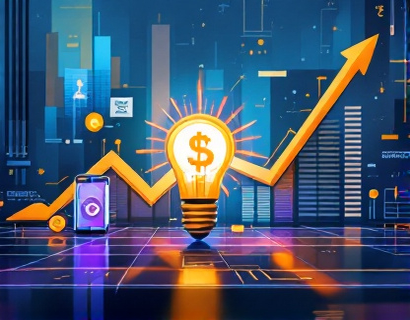Unlocking Strategic Growth: Advanced Tech Integration for Informed Decision-Making in Global Capital Markets
In the fast-paced and highly competitive world of global capital markets, the ability to make informed decisions swiftly and accurately is paramount. The integration of advanced technologies offers a transformative pathway to strategic growth, enabling financial analysts and decision-makers to navigate the complexities of the market with unprecedented precision. This article delves into the critical role of technology in enhancing decision-making processes, providing actionable strategies and deep insights for professionals in the financial sector.
The landscape of global capital markets is characterized by volatility, complexity, and an ever-increasing volume of data. Traditional methods of analysis often struggle to keep pace with these dynamics, leading to suboptimal decision-making. Advanced technologies, however, provide the tools necessary to transform vast amounts of data into actionable intelligence. By leveraging these technologies, financial professionals can gain a competitive edge, optimize portfolios, and identify emerging trends and opportunities.
Enhancing Data Analysis with Artificial Intelligence
Artificial Intelligence (AI) stands out as a revolutionary force in the realm of financial analytics. AI algorithms can process and analyze vast datasets at speeds unattainable by human analysts. This capability is particularly valuable in identifying patterns, predicting market movements, and assessing risk. Machine learning, a subset of AI, allows systems to learn from data, improving their accuracy over time without being explicitly programmed. For financial analysts, this means more reliable forecasts and a deeper understanding of market dynamics.
Implementing AI in capital markets analysis involves several key steps. First, data collection is crucial. This includes gathering historical market data, economic indicators, and real-time news feeds. Advanced data integration tools ensure that data from diverse sources is consolidated and standardized. Once data is collected, AI models can be trained to recognize patterns and make predictions. These models can be continuously refined with new data, enhancing their accuracy and reliability.
One of the most significant benefits of AI in financial analysis is its ability to handle unstructured data, such as news articles and social media posts. Natural Language Processing (NLP), a branch of AI, can analyze text data to gauge market sentiment and identify potential impacts on asset prices. This qualitative insight complements quantitative data, providing a more holistic view of the market.
Real-Time Data and Its Impact on Decision-Making
Real-time data is another critical component of advanced tech integration in capital markets. The speed at which information is processed and acted upon can mean the difference between capitalizing on an opportunity and missing it entirely. Real-time data feeds provide up-to-the-minute insights into market movements, allowing for immediate responses to changing conditions.
Trading platforms equipped with real-time data capabilities enable traders to execute trades with millisecond precision. This level of speed is essential in high-frequency trading, where even the smallest delays can result in significant financial losses. Beyond trading, real-time data is invaluable for risk management. By monitoring market conditions continuously, financial institutions can quickly identify and mitigate potential risks.
To harness the power of real-time data, financial organizations must invest in robust infrastructure. This includes high-speed networks, advanced data processing systems, and secure data storage solutions. Cloud computing plays a pivotal role in this infrastructure, offering scalable resources and enhanced flexibility. By leveraging cloud services, firms can access powerful computing resources on demand, ensuring they can handle large volumes of real-time data without compromising performance.
Blockchain Technology and Transparency
Blockchain technology is often associated with cryptocurrencies, but its applications extend far beyond digital currencies. In the context of global capital markets, blockchain offers a transformative approach to transparency and security. By providing a decentralized, immutable ledger, blockchain ensures that transactions are transparent, traceable, and tamper-proof.
For financial analysts, blockchain enhances the integrity of data sources. In traditional systems, data can be manipulated or altered, leading to inaccurate analyses. Blockchain eliminates this risk, providing a reliable foundation for data-driven decision-making. Additionally, smart contracts, self-executing contracts with the terms directly written into code, can automate and enforce agreements, reducing the need for intermediaries and lowering transaction costs.
Implementing blockchain in capital markets requires careful consideration of regulatory frameworks and interoperability with existing systems. However, the potential benefits are substantial. Enhanced transparency and security can foster greater trust among market participants, leading to more efficient and resilient financial systems.
Big Data Analytics for Comprehensive Insights
Big Data analytics is a cornerstone of advanced tech integration in financial analysis. The volume, velocity, and variety of data available today necessitate sophisticated tools to extract meaningful insights. Big Data platforms, such as Hadoop and Spark, enable the storage and processing of massive datasets, allowing for in-depth analysis.
One of the key applications of Big Data analytics in capital markets is portfolio optimization. By analyzing historical performance, market trends, and economic indicators, algorithms can identify the optimal asset mix for a given investment strategy. This data-driven approach minimizes risk and maximizes returns, a critical goal for investors and fund managers.
Another area where Big Data shines is in fraud detection. By monitoring transactions and user behavior in real-time, anomaly detection algorithms can identify suspicious activities and flag potential fraud. This proactive approach helps financial institutions protect themselves and their clients from financial losses due to fraudulent activities.
Integrating Advanced Visualization Tools
Data visualization is an essential component of effective decision-making. Complex data sets can be overwhelming, but advanced visualization tools transform raw data into intuitive and actionable insights. Interactive dashboards and charts allow users to explore data from multiple angles, identifying trends and correlations that might go unnoticed in raw data.
Tools like Tableau, Power BI, and QlikView offer powerful visualization capabilities tailored to financial data. These platforms can integrate with various data sources, including real-time feeds and Big Data platforms, providing a comprehensive view of market conditions. By visualizing data, analysts can quickly communicate findings to stakeholders, facilitating informed discussions and decisions.
Customization is a key feature of advanced visualization tools. Users can create personalized dashboards that highlight the metrics most relevant to their specific roles and objectives. This flexibility ensures that decision-makers have access to the information they need, when they need it, in a format that is easy to understand and act upon.
Cybersecurity: A Critical Component of Tech Integration
As financial organizations increasingly rely on advanced technologies, cybersecurity becomes a paramount concern. The integration of AI, blockchain, and Big Data brings new vulnerabilities that must be addressed to protect sensitive information and maintain operational integrity. Robust cybersecurity measures are essential to safeguard against cyber threats, data breaches, and other security risks.
Implementing a layered security approach is crucial. This includes firewalls, intrusion detection systems, and encryption technologies to protect data in transit and at rest. Regular security audits and penetration testing help identify and mitigate potential vulnerabilities. Employee training and awareness programs are also vital, as human error remains a significant risk factor in cybersecurity.
Collaboration with cybersecurity experts and adherence to industry best practices are essential steps in building a secure tech infrastructure. By prioritizing security, financial organizations can confidently leverage advanced technologies to drive strategic growth and informed decision-making.
Conclusion
The integration of advanced technologies represents a transformative opportunity for financial analysts and decision-makers in the global capital markets. By embracing AI, real-time data, blockchain, Big Data analytics, and advanced visualization tools, professionals can gain deeper insights, make more informed decisions, and drive strategic growth. However, this journey requires a commitment to innovation, a focus on data integrity, and a strong emphasis on cybersecurity. As the financial landscape continues to evolve, those who adapt and leverage these technologies will be best positioned to succeed.










































